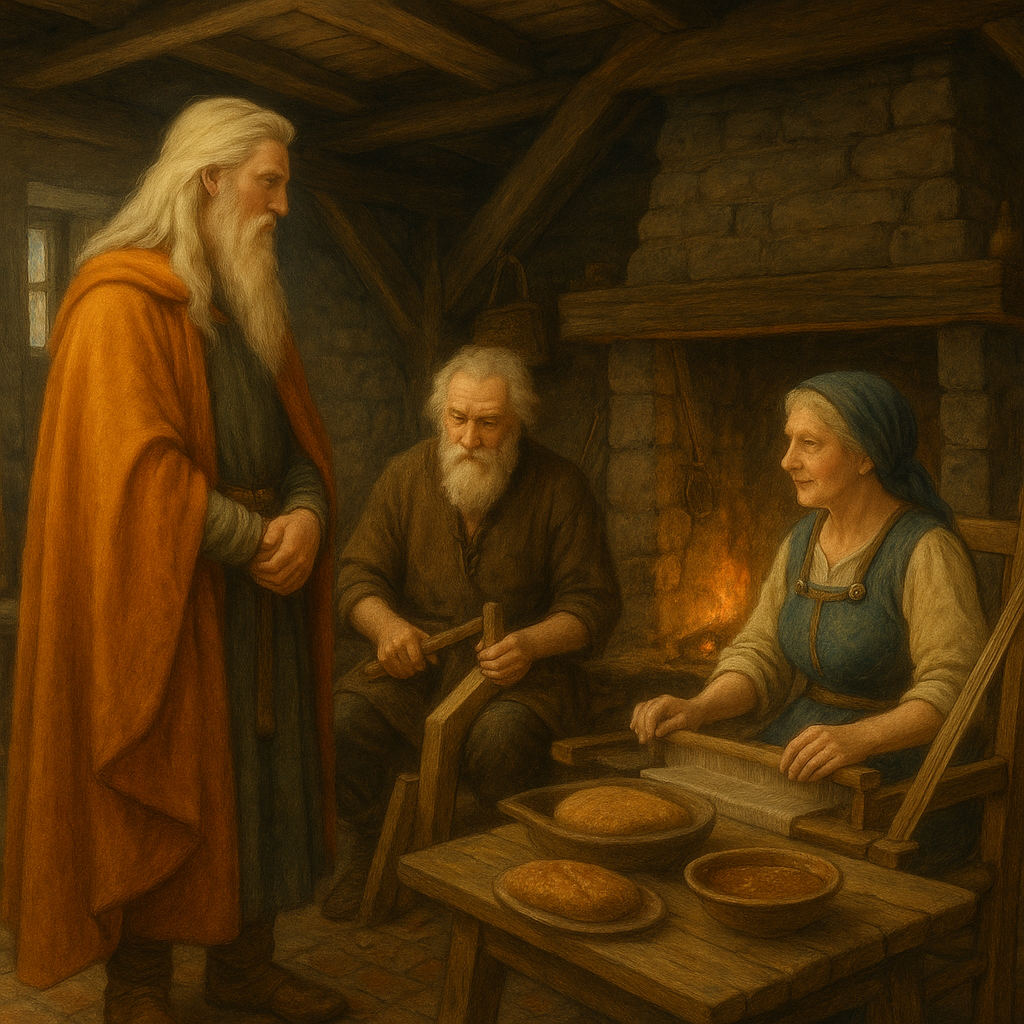The lay of Rig (Story Form)
Long ago, in the age when gods still walked among humankind, a tall and shining figure strode along the cold seashore. His name was Heimdall, though on this journey he called himself Ríg.
The sea wind caught his golden hair, and the gulls wheeled above him as he walked. He had left the halls of the gods to see the world of men - to know how they lived, and perhaps to shape their fates.
As Ríg wandered, he came to a small, smoky cottage by the shore. The door hung low, the walls were rough, and smoke curled from a fire pit in the floor.
Inside sat an old man and woman - Ai and Edda, Great-grandfather and Great-grandmother. Their clothes were coarse and patched, their hands rough with work.
Yet when Ríg knocked, they welcomed him warmly. They shared their meal - thick bread full of husks and a bowl of thin broth. They offered the best they had, and Ríg thanked them kindly.
That night, he rested between them by the fire, and when morning came, he went on his way.
In time, Edda bore a son. His skin was dark and wrinkled, his hands strong, and his back bent from toil. They named him Þræll, which means Thrall - the servant.
Þræll grew tall and sturdy. He carried heavy burdens, cut wood, and worked the fields. In time, he met a woman named Thir, with sunburned arms and calloused feet. They married, had many children, and their sons and daughters became the first of the Thralls - the workers, the servants, and the slaves who laboured in the land of men.
Ríg walked on and came to a brighter home. The walls were better built, the hearth wide and clean. Inside sat Afi and Amma (Grandfather and Grandmother) both busy with their work.
Afi was cutting wood for the loom beam, his beard neat and his tunic well fitted. Amma sat at her weaving, her hands quick and skilful, her kerchief pinned with shining clasps.
They greeted Ríg with respect and set before him good food: fresh bread made from white wheat and tender meat cooked with care.
He stayed three nights beneath their roof, and when he left, Amma gave birth to a son. They named him Karl - the Freeman.
Karl grew tall and strong. He yoked oxen, ploughed the fields, built barns and houses, and shaped carts and tools with his own hands. He married a fair woman named Snör, who carried keys at her belt - a mark of her place as mistress of the home.
They had many children, sons and daughters, and from them came the Freemen - the farmers, craftsmen, and traders who worked their land with pride and skill.
Ríg’s road led him next to a grand hall with tall doors facing the sun. The doorway was carved and hung with a gleaming ring, and within the floor was strewn with clean rushes.
There sat Faðir and Móðir (Father and Mother) proud and noble. Faðir worked at shaping bows and arrow shafts, while Móðir smoothed the silk sleeves of her gown. Her hair shone beneath a bright cap, her dress was blue and fine, and her neck was white as new-fallen snow.
They welcomed Ríg as an honoured guest. Móðir set the table with linen cloth and silver dishes, served roasted birds and red wine in gleaming cups. They feasted and spoke long into the evening.
That night, Ríg stayed with them, and after he departed, Móðir bore a son - Jarl, the Noble.
Jarl was fair haired and fierce eyed. As he grew, he learned to wield weapons - to bend bows, cast spears, and ride swift horses. He hunted in the woods, tamed hounds, and swam in the cold rivers.
Then one day, from the grove beyond the hall, Ríg returned. He taught Jarl the runes, symbols of wisdom and power - the hidden language of gods and fate.
Ríg claimed him as his own son and blessed him to rule. “Take your heritage,” said Ríg, “the lands and halls of your fathers. Rule them wisely, and let your sons be strong.”
Jarl rode forth and won great battles. He conquered lands and built eighteen halls, sharing gold and gifts with his men. His fame spread far and wide.
In time, Jarl married a fair maiden named Erna, daughter of Hersir, a local lord. Together they had many sons - brave and skilled, hunters and warriors all.
But the youngest was Kon the Young, and he was different from his brothers. He learned the runes as Ríg had taught them, and soon he could still the waves, calm fire, speak with birds, and ease sorrow. His strength was that of eight men, and his wisdom was deep as the sea.
At last, Kon claimed the name Ríg, as his forefather had borne before him - the divine wanderer’s name, the name of the one who binds gods and men.
And though the rest of his tale is lost, it is said that from Kon descended the first kings of men, the line of rulers who united the three clans (Thrall, Karl, and Jarl) into one people.
So ends the Lay of Ríg - the story of how the god walked the earth and gave the world its shape.
From the humble to the noble, all are children of Ríg.
The strong arm that works, the steady hand that builds, the wise heart that leads - all bear the same divine spark.
And though the poem’s end is lost to time, its truth remains:
every person, whether slave, farmer, or king, is born from the same god who once walked the green earth and smiled upon humankind.









